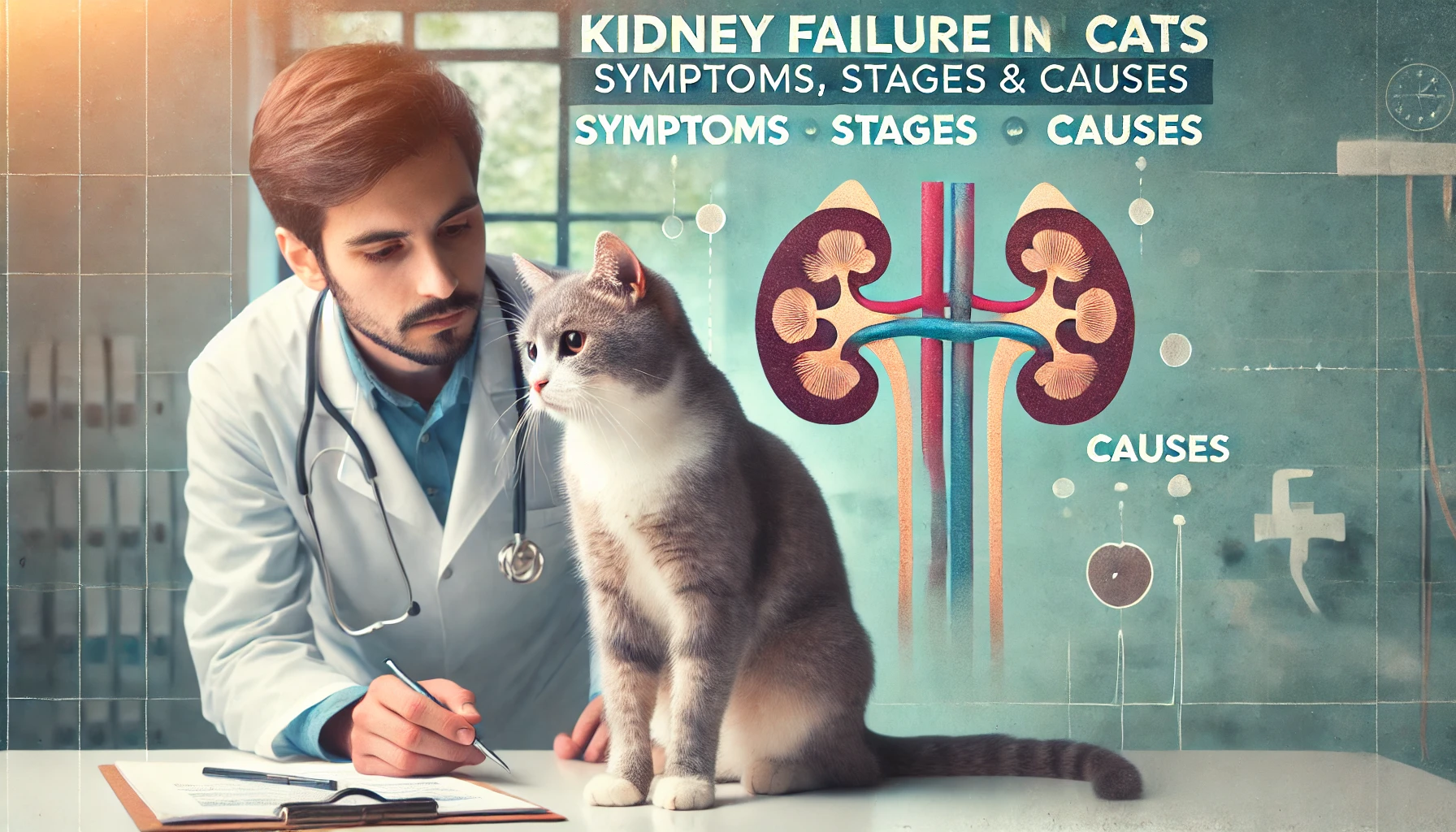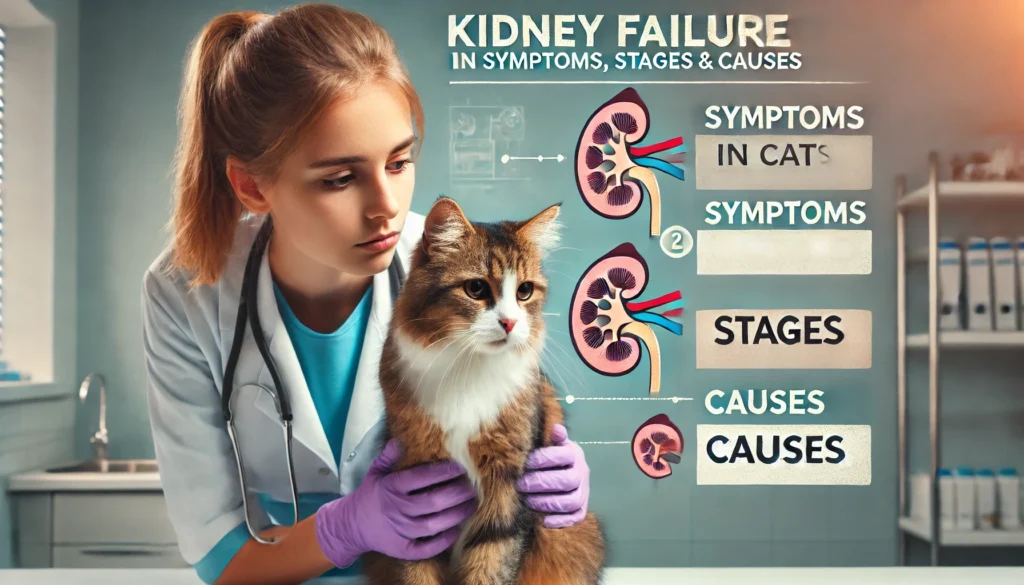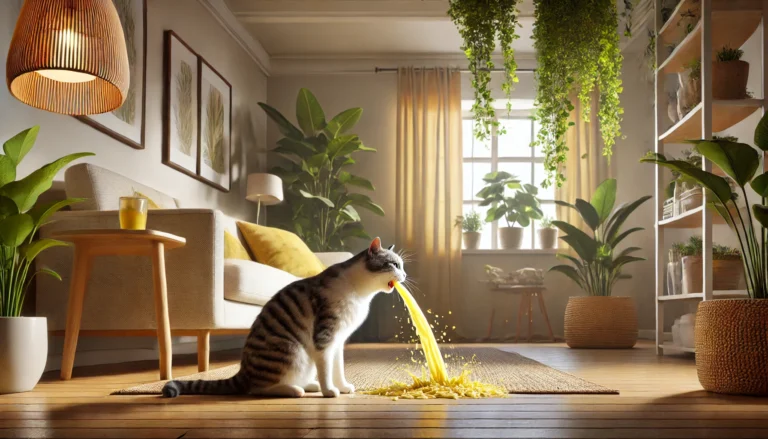Kidney Failure in Cats: Symptoms, Stages and Causes

introduction
Kidney Failure in Cats, often referred to as renal failure or feline kidney disease, is a common ailment that can significantly affect the health and quality of life of our feline friends. This detailed article delves into the types, symptoms, stages, and causes of kidney disease in cats, providing cat owners with the necessary knowledge to identify and manage this condition effectively.
Understanding Kidney Failure in Cats
Kidney failure—or renal failure as it’s scientifically known—occurs when a cat’s kidneys lose their ability to filter waste products from the blood efficiently. This deficiency can lead to a dangerous buildup of toxins in the body that are normally expelled in the urine.
Types of Kidney Failure
Kidney Failure in Cats can be classified into two types:
- Acute Kidney Failure in Cats: This type occurs suddenly, typically due to an infection, exposure to toxins, or shock. It can affect cats of all ages and is characterized by rapid onset symptoms.
- Chronic Kidney Failure in Cats: More common in cats, this form develops slowly over months or even years, often due to aging or long-standing disease. It’s particularly prevalent in middle-aged and senior cats.
Symptoms of Kidney Failure in Cats
The symptoms of kidney failure in cats can vary but typically include the following:
- Increased Thirst and Urination: Cats with kidney failure may drink and urinate more than usual.
- Weight Loss and Decreased Appetite: Affected cats may show a marked reduction in appetite and can lose weight rapidly.
- Lethargy: Cats often exhibit decreased energy levels and general weakness.
- Vomiting and Diarrhea: Gastrointestinal symptoms such as vomiting and diarrhea are common.
- Poor Coat Quality: The coat of a cat with kidney disease may look unkempt or dull.
- Foul Breath: A chemical smell or ammonia-like odor from the mouth can be a sign of toxins building up in the body.
do you know
It’s always worrying when your furry friend starts sneezing and looking unwell. If your cat has a cold, it’s important to recognize the symptoms early and act quickly.
Stages of Kidney Disease in Cats
Veterinarians often use a staging system to classify the degree of kidney failure in cats, which helps in determining the treatment strategy:
- Stage 1 (Early): Kidney function is slightly diminished, but few outward symptoms may be evident.
- Stage 2 (Mild): Creatinine levels increase as kidney function declines, and symptoms like increased thirst and urination become more noticeable.
- Stage 3 (Moderate): Clinical signs such as nausea, vomiting, and lethargy are evident, and the impact on health becomes more severe.
- Stage 4 (Severe): This final stage is characterized by a significant loss of kidney function, with symptoms affecting multiple body systems.

Causes of Kidney Failure in Cats
Various factors can contribute to the development of kidney disease in cats, including:
- Aging: Just like humans, cats’ kidney functions decline with age.
- Genetic Predisposition: Some breeds are more susceptible to kidney problems.
- Diet: A diet high in phosphorus can contribute to kidney disease.
- Underlying Health Issues: Conditions like diabetes and high blood pressure can damage the kidneys over time.
- Exposure to Toxins: Certain chemicals, such as antifreeze, certain medications, and toxic plants, can cause acute renal failure.
Managing Kidney Failure in Cats
Management of Kidney Failure in Cats includes dietary modifications, fluid therapy, and medications to manage symptoms such as high blood pressure and anemia. Kidney Failure in Cats often benefit from a diet that is low in protein, phosphorus, and sodium but rich in omega-3 fatty acids.
End-of-Life Considerations
Deciding when to euthanize a Kidney Failure in Cats is a personal and difficult decision. It typically comes when the cat’s quality of life has significantly deteriorated, and pain and discomfort cannot be effectively managed.
Prognosis
The prognosis for a Kidney Failure in Cats depends on a variety of factors, including the stage of the disease, the cat’s overall health, and how well the disease responds to treatment. Early detection and proactive management can improve quality of life and prolong life in many cases.
Conclusion
Kidney failure in cats is a significant disease that requires careful management and can deeply impact the health and well-being of affected cats. By understanding the symptoms, stages, and causes of kidney disease, cat owners can better manage their pet’s condition and make informed decisions about their care. Regular veterinary check-ups and prompt attention to changes in health can help catch kidney disease early, which is crucial for effective management and extending the life of our beloved feline companions.
What are the 4 stages of kidney failure in cats?
The four stages of kidney failure in cats are categorized based on the severity of the disease and the levels of waste products in the blood, particularly creatinine:
Stage 1: Early kidney insufficiency where creatinine levels are normal but there may be subtle signs such as slightly increased water consumption.
Stage 2: Mild kidney failure with creatinine levels typically between 1.6 to 2.8 mg/dL. Symptoms like increased thirst and urination become noticeable.
Stage 3: Moderate kidney failure where creatinine levels range from 2.9 to 5.0 mg/dL. Symptoms are more pronounced, including decreased appetite, lethargy, and potentially nausea.
Stage 4: Severe kidney failure with creatinine levels above 5.0 mg/dL. This stage shows significant symptoms including vomiting, dehydration, and poor quality of life.
What are the symptoms of early stage kidney failure in cats?
Symptoms of early stage kidney failure in cats are often subtle and can be easily overlooked. These include:
Slight increase in thirst and urination: As the kidney’s ability to concentrate urine diminishes, affected cats may begin to drink and urinate more.
Mild weight loss and decreased appetite: These signs can start slowly and may not be noticeable at first.
Mild lethargy: Cats may show a slight decrease in activity level. Early detection through regular veterinary check-ups can help identify these signs before they become more severe.
What is stage 3 kidney disease in cats?
Stage 3 kidney disease in cats is considered moderate kidney failure. At this stage, creatinine levels are typically between 2.9 to 5.0 mg/dL. Cats may exhibit noticeable and more severe symptoms including:
Increased thirst and urination
Nausea and vomiting
Lethargy and depression
Weight loss
Poor coat condition It’s crucial at this stage to manage the disease with interventions such as dietary changes, medications, and possibly subcutaneous fluid therapy to improve quality of life.
How long can a cat live with early stage kidney failure?
The lifespan of a cat with early stage kidney failure can vary widely depending on several factors such as the cat’s overall health, age, and how well the disease is managed. With appropriate care, including diet modification and regular veterinary monitoring, cats can live many years with good quality of life. Early detection and intervention are key to managing the disease effectively and prolonging life.
What is stage 5 renal failure in cats?
Cats typically are categorized only up to Stage 4 kidney failure as per veterinary standards set by the International Renal Interest Society (IRIS). There is no officially recognized Stage 5 kidney failure in cats. Stage 4 is considered end-stage renal disease with severe symptoms and very high creatinine levels, where management is focused on palliative care and maintaining quality of life.
Can a cat recover from stage 4 kidney failure?
Recovery from Stage 4 kidney failure in cats is not typically possible since this stage represents end-stage disease. Treatment focuses on palliation—relieving symptoms without curing the underlying disease. With aggressive management, including fluid therapy, dietary adjustments, and possibly medications, some improvement in symptoms and stabilization of the condition can be achieved, potentially extending life for a period of time.
What is the last stage in a cat’s life cycle?
The last stage in a cat’s life cycle is often referred to as the geriatric phase, which varies widely among individual cats but generally begins around the age of 15 years. This stage is characterized by a gradual decline in physical and cognitive functions. Health issues, such as kidney disease, arthritis, or decreased senses, become more prevalent. Care during this stage focuses on comfort and maintaining the best possible quality of life.
Is end stage kidney failure in cats painful?
End stage kidney failure in cats can be associated with symptoms that may cause discomfort or pain, such as nausea, vomiting, dehydration, and weakness. However, with appropriate palliative care, including pain management and measures to reduce other distressing symptoms, cats can be kept comfortable. Regular veterinary care is crucial to ensure that pain and any discomfort are adequately managed.
What is the last stage of kidney failure before death?
The last stage of kidney failure before death in cats is Stage 4, where the kidneys are no longer able to effectively filter toxins from the blood, resulting in severe clinical signs like vomiting, severe lethargy, and complete loss of appetite. Management at this stage is focused on comfort and palliative care, as the disease is irreversible and terminal at this point.
What not to feed a cat with kidney disease?
Cats with kidney disease should avoid high-protein, high-phosphorus, and high-sodium diets as these can exacerbate the condition. Avoid foods that are high in animal by-products or fillers that might be hard on the kidneys. Instead, feed renal-specific veterinary diets that are formulated to support kidney function and reduce the workload on the kidneys.
How to tell if a cat has organ failure?
Signs that a cat may be experiencing organ failure include marked lethargy, decreased appetite or anorexia, vomiting, diarrhea, weight loss, and changes in water consumption and urination habits. Specific symptoms can vary depending on the organ involved. Prompt veterinary evaluation is necessary to diagnose and address organ failure.
What are the symptoms of worsening kidney disease?
Symptoms of worsening kidney disease in cats include increased frequency and volume of urination, heightened thirst, significant weight loss, decreased appetite, vomiting, diarrhea, dull and unkempt coat, oral ulcers, and a distinct ammonia-like odor on the breath. As the disease progresses, more severe symptoms such as dehydration, lethargy, and an inability to urinate can occur, indicating critical deterioration in kidney function.






